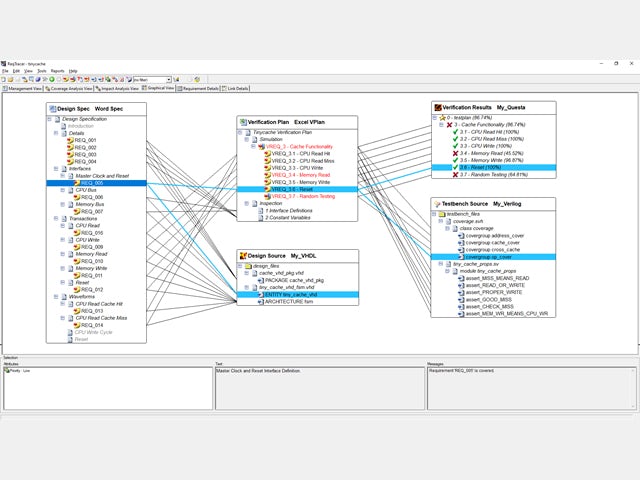ReqTracer
Overview
ReqTracer links, manages, and tracks requirements from multiple sources throughout the design process. It also provides automated documentation and reports at any stage and manages the impact of requirement changes.
Determining if design requirements are met implies you can track them from specification through RTL description and on to verification results—a best practice for any requirements-based design flow. ReqTracer lets you easily implement and track a requirements-driven project development process.
Introducing ReqTracer
The ability to completely trace and manage design requirements from specification through implementation and verification is simply “good project management”. ReqTracer facilitates the deployment of a requirements-driven design flow, while allowing project teams to focus on their implementation and verification work for maximum efficiency.
It is only when functionality and verification results fully meet the requirements, that a project is complete and the project team can confidently put the product into production. This is beneficial to all projects, but especially needed in Safety Critical applications and mandatory for DO-254 and ISO 26262 certification, where product failure could result in injuries or fatalities.

Project Management
ReqTracer provides an interactive tool to help implement and track a requirements-driven project development process, and facilitate continuous process improvement.
Requirements Traceability
ReqTracer is an efficient solution for managing requirements traceability and impact analysis across hardware and software project lifecycles. ReqTracer simplifies, automates, and enables requirements traceability from specification of the hardware specification through HDL coding, implementation, and validation.
Safety-Critical Design
ReqTracer provides detailed tracing of requirements into design source and verification results to demonstrate a verified implementation for regulatory compliance.
ASIC/FPGA Verification
ReqTracer bridges the gap between design spec and requirements to enhance both traditional (directed test) and advanced verification productivity and effectiveness.
Key Features and Benefits
- Improve overall project quality with automated requirement coverage analysis across multiple engineering disciplines
- Trace requirements throughout the design process
- Facilitate process improvements and best practices
- Assess and manage the impact of requirement changes
- Confirm that design requirements have been fully implemented and tested
- Link all project documents with design, verification, and implementation tools
- Fulfil key regulatory mandates for safety standard compliance
- Communicate through visual and intuitive automated status reports
Interested in ReqTracer?
Contact us to Learn More
Tools for FPGA & ASIC Design

HDL Designer
Visualising RTL Design
With deep analysis capabilities, advanced creation editors, and complete project and flow management, HDL Designer delivers a powerful HDL design environment.

Precision Series
FPGA Synthesis
Provides FPGA vendor-independent logic synthesis, offering reduced time to market, fewer design defects, and superior quality of results. The powerful optimisation engines, context sensitive GUI, …

ModelSim
HDL Simulation
ModelSim’s award winning Single Kernel Simulator (SKS) technology enables transparent mixing of VHDL and Verilog in one design.

QuestaSim
Simulation and Debug
Combines high performance and capacity simulation with unified advanced debug and functional coverage for the most complete native support of Verilog, SystemVerilog, VHDL, …

Catapult HLS
High-Level Synthesis and Verification
Industry leading C++ / SystemC High-Level Synthesis with Low-Power estimation / optimization. Design checking, code, and functional coverage verification plus formal make HLS more than ….

ReqTracer
Requirements Management
Simplifies, automates, and enables requirements traceability from specification of the hardware specification through HDL coding, implementation, and validation.

